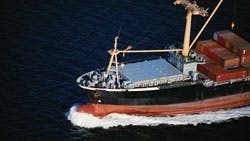Cargo Thieves Beware: Technology is Tracking You
In 2010, industry-wide cargo theft rose by 4.1% from the previous year and averaged 75 cargo theft incidents per month, a new record high.
One of the keys to cargo security is visibility of assets: knowing where your goods are and tracking them from the warehouse to the shipyard and/or rail yard and finally to the customer. For instance, Purdue Pharma (www.purduepharma.com), a U.S. pharmaceutical manufacturing company, added RFID labels to its products to meet retailer mandates, but also in anticipation of new federal and state regulatory requirements to combat counterfeit and stolen drugs – a rapidly growing market that costs the industry more than $30 billion each year worldwide. The RFID tags allow Purdue, its wholesale partner and retailer to track every shipment and share product and shipment information at each step throughout the supply chain journey. Each RFID-tagged product can be traced through the supply chain from its origin and manufacturing date to its destination shipment point, ensuring product integrity and safety.
About five years ago, the shipping industry began putting RFID tags on containers to indicate if tampering had taken place during transport. One of the issues with such tags is how to return them to the owner or forward them to the next party wanting to use them. For instance, produce companies use a monitoring box in their containers that has return postage on it.
RFID, video surveillance, GPS and mobile computing solutions are among the technologies currently being deployed to help companies manage fleets and monitor assets while en route. While no security solution is infallible, with the right asset tracking technology, companies can minimize the risk of theft and attempt to prevent it.
For the cargo industry, it has become vitally important to have some type of sensing security on containers that can show unusual vibration, such as from a cutting tool or heat from a blow torch. The sensor then sends an alert directly via WAN or LAN to a monitoring company. Or the sensor can be connected to a truck with a monitoring device (a server) that communicates messages back to a control center or security operation.
Real-Time Data
Shipyards, rail yards, trucking yards and airports are using outdoor wireless access points that allow streaming video via 80211n to monitor large areas via video cameras. Instead of having to hire people to monitor the many cameras placed around a property, these and other industries are implementing video analytics such as “sit-and-send” alerts to virtually patrol their properties.
For instance, if a car has been sitting by a perimeter fence more than five minutes, the software program flags it and sends an alert to a responsible person via a handheld device indicating that the car needs to be investigated. Or if a piece of luggage is left unattended at an airport gate, the program can send an emergency alert to the security staff. Currently, Houston’s George H.W. Bush International Airport and Newark International Airport use video cameras for parking lot surveillance, which is generating good results.
By implementing technology solutions all along the supply chain, companies can reduce thefts, improve their operations, reduce their costs and boost their bottom line.
Mike Maris is senior director of transportation and logistics for Motorola Solutions (www.motorola.com).
